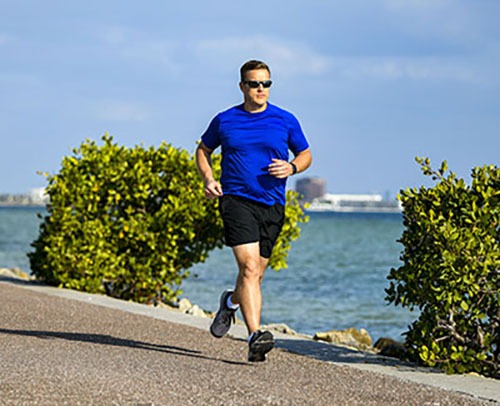Steps to Enhance Physical Health Through Exercise
Exercise is a cornerstone of good health, offering numerous benefits for both the body and mind. As we delve into the steps to enhance physical health through exercise, it’s important to remember that the journey to better health is personal and should be tailored to individual needs, preferences, and fitness levels. The following sections will provide practical guidance on choosing appropriate exercises, setting realistic goals, creating consistent routines, and optimizing nutrition to support your fitness journey.
Choosing the Right Types of Exercise
Choosing exercises that match your fitness level and goals is crucial for improving your physical health. Activities such as brisk walking, swimming, or cycling at a pace that increases your breathing and heart rate are examples of moderate-intensity exercises. Engaging in more vigorous activities like aerobics, basketball, or running involves higher effort levels, leading to rapid breathing and a significant elevation in heart rate. Both types of exercise offer numerous health benefits, including improved cardiovascular fitness and enhanced mood.
Effexor, an antidepressant medication, can be beneficial for mental health by helping to regulate mood and alleviate symptoms of depression and anxiety. However, some individuals may experience effexor weight gain as a side effect, which can be managed through a combination of diet and exercise. Regular physical activity not only supports overall health but can also help counteract potential weight-related side effects of medications.
Both moderate and vigorous forms of exercise have a lot to offer in terms of health advantages, from better cardiovascular fitness to improved moods and general well-being. When combined with appropriate medical treatment, exercise can play a significant role in managing mental health conditions and promoting overall wellness.
Aerobic Exercise
Aerobic exercises, also known as cardio, improve cardiovascular health and endurance. Examples include:
- Brisk walking
- jogging
- Swimming
- Cycling
Strength Training
Strength training builds muscle, increases bone density, and boosts metabolism. Try:
- Weightlifting
- Bodyweight exercises (push-ups, squats)
- Resistance band workouts
Flexibility Exercises
Flexibility exercises enhance the range of motion and reduce injury risk. Consider:
- Yoga
- Stretching routines
- Pilates
Setting Realistic Goals
Achievable fitness goals are crucial for long-term success. The effectiveness of goal-setting can be significantly improved by applying the SMART criterion. Measurable objectives enable you to gauge your growth and evaluate your progress over time. Realistic and reachable goals fit into your existing resources and level of fitness. Relevant goals make an important difference to your overall health objectives and overall well-being.
Time-bound goals, such as committing to yoga twice a week for the next two months, provide deadlines to achieve fitness milestones. Setting structured, achievable fitness goals boosts motivation and fosters sustainable long-term fitness progress using the SMART criteria.
Creating a Consistent Exercise Routine
Source: Canva
To fully benefit from exercise, consistency is essential. It takes an average of 66 days, according to research, to acquire a new habit, such as starting an exercise regimen. Implementing tactics that support your commitment to physical activity is crucial for consistency. To prioritize exercise time, start by booking workouts in your calendar just like any other important appointment. As your fitness level rises, start with a reasonable frequency of physical activity, like three times a week, then gradually increase. Enrolling in a fitness class or finding an accountability partner can offer motivation and support, which will help you maintain your workout schedule.
Overcoming common barriers:
| Barrier | Solution |
| Lack of time | Break workouts into shorter, more frequent sessions |
| Low motivation | Set small, achievable goals and reward yourself |
| Physical discomfort | Start slowly and gradually increase the intensity |
| Boredom | Try new activities or work with friends |
Nutrition and Hydration for Optimal Exercise
For activities to be as successful as feasible and to speed up recovery, a proper diet and water are crucial. The American College of Sports Medicine states that 16–20 ounces of water should be drunk four hours before activity, and another 8–12 ounces should be consumed ten minutes before exercise begins. Aim for well-balanced meals high in lean proteins and complex carbs before, steering clear of heavy, greasy items that might make you feel uneasy. To assist muscle repair and boost energy levels after exercise, try to eat protein and replenish carbohydrates within 30 to 60 minutes of finishing the exercise. For best results and recuperation, modify your intake based on the length and intensity of your workout.
Monitoring Progress and Making Adjustments
To stay inspired and make sure you’re moving in the right direction toward your fitness goals, it’s essential to keep track of your progress. Good practices include recording workouts and achievements in a diary, tracking changes graphically with regular body measurements or progress images, and tracking activity levels and accomplishments with wearable technology or fitness apps. Regular fitness evaluations, such as strength tests or timed runs, offer objective standards for progress over time. As you develop, modify your regimen to include heavier weights, more difficult exercises, or longer workouts to maintain your progress and make continuous improvements to your fitness journey.
Incorporating Variety and Rest Days
Try new exercise classes, try out different workout formats like circuit training or HIIT, and get outside and participate in sports or hiking to add variety to your workouts and prevent boredom and plateaus in your fitness quest. Rest days are just as important to your exercise routine since they help with muscle repair and burnout prevention. Emphasize exercises like mild yoga, light stretching, or active recovery activities like a stroll or swim on rest days. Sustaining development and satisfaction in your training regimen is ensured by striking an equilibrium between variance and sufficient recovery.
FAQs
How can exercise improve your physical health?
Exercise enhances cardiovascular function, strengthens muscles, improves flexibility, boosts mood, and aids in weight management, contributing to overall well-being and longevity.
What are 4 ways to improve physical health?
Engage in regular exercise, maintain a balanced diet, ensure adequate sleep, and practice effective stress management techniques.
What are 10 ways to improve your fitness level?
Incorporate cardio workouts, engage in strength training, practice flexibility exercises, prioritize hydration, get sufficient rest, set specific goals, track progress, vary workouts regularly, seek professional guidance, and maintain consistency in your fitness routine.
What are the 5 steps to developing a physical activity plan?
- Assess Your Current Fitness Level: Evaluate strengths and areas for improvement.
- Set realistic Goals: Define specific, achievable objectives.
- Choose Suitable Activities: Select exercises you enjoy and align with your goals.
- Create a Schedule: Establish a consistent workout routine.
- Monitor and Adjust: Track progress, and modify as needed for continued improvement and motivation.
Conclusion
Enhancing your physical health through exercise is a journey that requires patience, consistency, and dedication. By choosing the right types of exercise, setting realistic goals, maintaining consistency, fueling your body properly, and monitoring your progress, you’ll be well on your way to improved health and fitness.
Remember, the key is to start where you are and progress gradually. Every step forward, no matter how small, is a step towards better health.
Keep an eye for more news & updates on Nextweblog!






